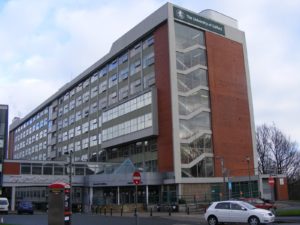
Maxwell Building, Salford University
The University of Salford is an outstanding educational institution with over 20,000 students. It has an impressive 20 year campus development plan that is seen as part of an ongoing process to provide students with the greatest access to leading facilities. As part of this development plan and to comply with the Equality Act 2010 the University decided to install Assistive Listening Devices in the form of Ampetronic Hearing Loops.
The project was a very large installation venture encompassing many different lecture halls and rooms of varying sizes, needs and uses. Many unique designs were required, and some of the systems had to consider adjacent or parallel rooms, requiring low spill systems to ensure that the loops do not interfere with another.
Using Ampetronic technology and design distributed through Audio Logic the installer RocheAV did a superb job and completed this colossal task on time and to an exceptionally high standard and this, together with the Ampetronic system designs RocheAV were able to achieve IEC60118-4 2006 standard compliance for every installed hearing loop.
Room A112
The requirement was to cover a long rectangular portion of the room, so a simple Phases Array was designed using two ILD300 to power the magnetic field from the induction loop.
Equipment used in A112
Rooms 234,235,236/237,238/239,240,
This same design was implemented into many different rooms as they were all either exactly the same or close enough so that the minute differences would not affect the loops ability and would still easily achieve IEC60118-4 2006 standard compliance.
Equipment used in each room:
Room AH305
An unusually shaped corner room, and the design reflected this so as to still provide coverage within the desired area and subsequently the room in its entirety. The room utilised a pair of ILD300 amplifiers to drive the loop system.
Equipment used in AH305:
Room G10
Although this system was designed to only provide coverage for the seating area the loop also covers the majority of the lecture theatre, this means that students approaching the front can also continue to benefit from the hearing loop.
Equipment used in G10:
Peel 338
Although this room has such a simple rectangular shape the design and therefore installation was a straightforward and simple process it was a larger area of coverage that was required so subsequently it used a pair of the more powerful ILD500 amplifiers to drive the hearing loop and magnetic field.
Equipment used in 338:
Allerton L508 & L509
Both of these loops were designed, installed and implemented very closely together and was also within relatively close proximity with other parallel systems, this meant that meticulous design was essential here for ensuring that all of the hearing loops did not interfere with one another.
Equipment used in each room:
Room 337
This system was also carefully designed with simulation software to carefully control the spill from outside of the room. This room however was a much larger space and therefore a more powerful amplifier was required, a pair of ILD500 amplifiers were chosen to drive this system.
Equipment used in room 337
Allerton Building Rooms L524 & L530
These systems were not required to control spill outside that of the coverage area and therefore the designing process was a relatively easy process as the room was a simple shape. The design could also be used in two rooms as they were identical in size and shape.
Image Credit – Ian Roberts